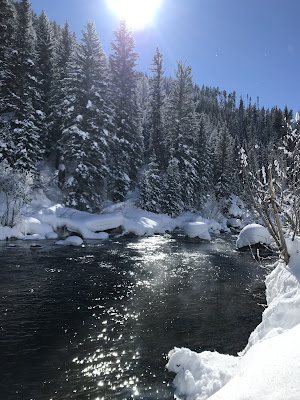The river resonates trickles, bubbles, and ripples with the existence of what a river is. The river offers great sections for the fisherman to catch beautiful fish. Before making the initial cast, it is crucial to take a moment to read the water. Taking the time to read the water will help determine the most likely places where fish are congregating. With rivers, fish typically don't usually live right in the fast water. The fish yearn for sections where they can hold in slower water, but still have access to the food conveyer belt.
Reading the water is essential to find where fish live in a river and where the successful fly fisherman then can use skill to present their fly cleverly to the trout. I often will hold back my excitement and take the time to read the water at a safe viewable distance.
Look for riffles, or a shallow section of the river where water cascades over rocks creating a surface disturbance. Riffles are choppy at the surface, or whitewater that rides over shallow rocks into deeper water. Shallow riffles are especially oxygenated waters and can be a marvelous habitat for aquatic insects fish fancy to eat. Some of the deeper riffles with rocks and boulders downstream offer trout rest and a copesetic spot away from predators. Where riffles drop into deeper water give fish a leisure current just below the drop off and a superb of offerings of insects that are swept over the edge.
A seam is any region where two adjacent water currents converge where one is slower then the other. This could be an obstruction such as a log, a boulder, or an extension of the shore which causes an unmistakable disruption from the main current flow. Trout relish seams and foamy bubble trails as they create feeding lanes that collect and deliver food.
Runs are an area directly from riffles and where the water current become more uniform and deeper. In reading the water, runs are an excellent place to look for fish in a river or stream. Fish seek shelter in the deeper water as well as the near vicinity for a quick meal. Fish often suspend at the edge of the current or drift along the bottom eating bugs that are surrendered downstream below the riffle.
A pool is the deepest segment of a river with a leisure moving current. I like to call these sections, fish pots. Fish will often advance to a pot on brilliant, sunny day, or if they sense danger. Quite often, the big fish typically may spend a good portion of their day in these pools where they are less active. Approach quietly and a little distance from the river banks before the cast. Don't be that guy wading in first to the middle of the fish pot.
An eddy is a point of where structures or an depression of the riverbank such as a sizable boulder, a log, or a fallen tree disturbs the river current and direction flow. Directly downstream of the object, a pocket of swirling water will form opposite the main direction of current flow. Fish are fond of eddies because they entrap and channel insects drifting by in the current. Look for foam or bubbles collecting on the surface of the water where the main current meets up with the swirling water and place your casts there.
A tailout is a shallow, even section at the end of a pool before the water descents down into another riffle. A natural funnel is formed which carries anything drifting downstream directly to the fish. Fish will often reprieve in a tailout and sip on hatching insects off the surface as they float by. Look for rising fish and make your cast.
Below the water surface, search for changes in the river such as shelves, gravel beds, bends, and contours of the river bottom. Fish will often be slumbering and feeding on the deeper side of these areas. Fish frequently rest in the poky current below the drop-off from a riffle gorging on insects that come over the brim.
Before making the first cast, take the time to read the water. Select a section of water and which structure to target. Experience is the key to success, so understand the bubbles, trickles, and structure of the water approaching it can lead to prosperous day of catching more fish. See you on the river!






No comments:
Post a Comment